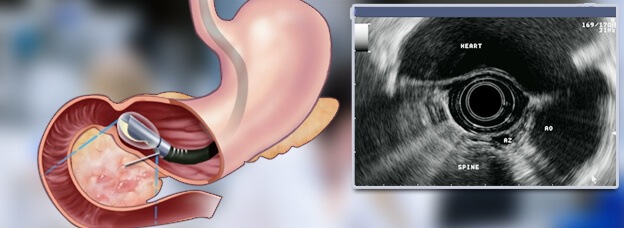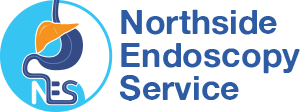Endoscopic Ultrasound
Endoscopic Ultrasound (EUS) combines endoscopy and ultrasound in order to obtain images and information about the digestive tract and the surrounding tissue and organs as well as the evaluation of surrounding blood vessels. EUS uses high-frequency sound waves to produce images within and outside the gastrointestinal tract which can be imaged to see if they are abnormal. This is performed by passing the endoscope through the mouth and advanced to through the oesophagus to the suspicious area. From various positions between the oesophagus and duodenum organs within and outside the gastrointestinal tract can be imaged to see if they are abnormal and they can be biopsied by a process called “fine needle aspiration or FNA.” Organs such as the liver, pancreas and adrenal glands are easily biopsied as are any abnormal lymph nodes. In addition, the gastrointestinal wall itself can be imaged to see if it is abnormally thick suggesting inflammation or malignancy. This test can also be performed through the rectum. EUS is a cost-effective, non-surgical assessment for certain diseases and as it is a technically demanding and complex procedure.
This method is superior in staging and diagnosing of gastrointestinal cancer and benign diseases in oesophagus, stomach, pancreas, and related organs. EUS have shown to be superior in assessment of the common bile duct in patients suspected for common bile duct stones or tumours.
It also allows for a biopsy to be performred of any focal lesions found in the upper gastrointestinal tract. This is done by inserting a needle through the stomach lining into the target tissue to obtain samples by passing a special needle, under ultrasound guidance, into enlarged lymph nodes or suspicious tumors. The tissue or cells obtained by the needle can be examined by a pathologist under a microscope. The process of obtaining tissue with a thin needle is called Fine Needle Aspiration (FNA). Please ensure you let your physician know if you take any medications that result in thinning of your blood (e.g. Aspirin, Plavix, Xarelto, Warfarin) as this may effect proceeding with your test.
How are you prepared?
The preparation for an EUS is similar to a gastroscopy/endoscopy.
- No alcohol to be consumed and stop smoking 12 hours before your procedure
- Cease solid food for six (6) hours before your procedure
- Drink water – 1 glass per hour until 2 hours before your procedure
- Nothing further to drink until after your procedure
While fasting take all regular medication with a sip of water at least three hours prior to procedure.
If you have serious heart or chest problems or drug allergies, special precautions need to be taken to reduce any risk. You should therefore inform the doctor of any serious conditions of this nature.
If you are diabetic, withhold your morning medication and bring it and a sandwich with you to take following the procedure.
At the beginning of the procedure you will be given a sedative by injection into a vein to make you comfortable and relaxed. The procedure will take between 5 – 15 minutes and you will be sleepy for about half an hour afterwards. Risks
EUS is commonly used as a diagnostic tool and has a low 0.2% risk of serious complications.
Potential serious complications include a perforation (tear in the lining of the digestive track) however this is extremely rare occurring in 1 in 2000 procedures. Bleeding complications after a fine needle aspiration (FNA) is also rare. Other complications related to EUS are sedation associated adverse events, similar to the same as for patients undergoing a gastroscopy/endoscopy. This includes a temporary drop in blood pressure and oxygen saturations. These developments are often a result of overmedication and can be easily reversed if necessary.

